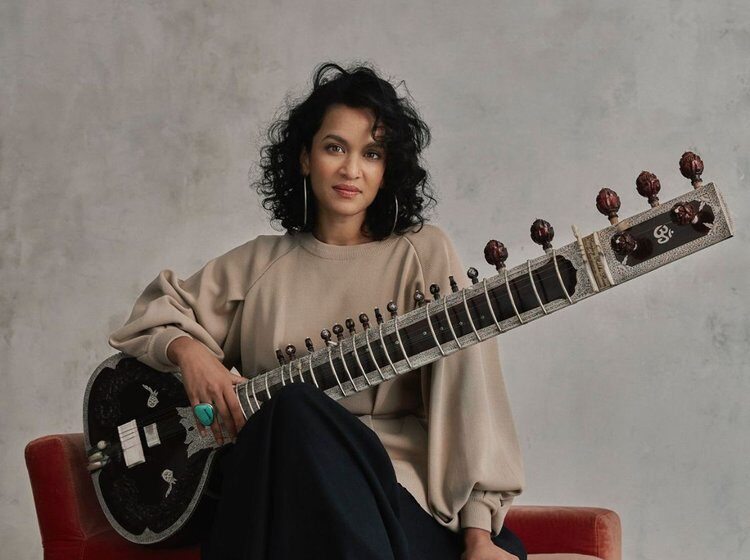The Beatles’ legendary trip to India in 1968 left its mark on the history of popular music. They were the most successful band on the planet, but they were no longer playing live by then. No venues were suitable for such an overflow of people – nor sound capable of dealing with the shouting. And that inability only increased the madness for them. They needed to get away from the media, the fans, and a society that lived on them 24 hours a day. India was the right place to go: not only did they meditate and soak up a new culture, but they wrote 48 songs – probably their most fruitful harvest. However, the Fab Four’s connection with this country wasn’t accidental: it originated a few years earlier, from George Harrison’s fascination with Indian music, his sitar lessons and his meetings with Ravi Shankar.
Harrison began introducing his Indian influence into the Beatles’ songs around 1965. Thanks to him, the sitar became popular among rock bands of the time. Psychedelia empathized with those sounds: Indian music became part of hippie culture. George’s 1968 Wonderwall Music soundtrack album was partially recorded in Bombay with Indian musicians and instruments little known in the West such as the shehnai, the sarod, and the santoor. True to his adventurous spirit and humble curiosity, the British guitarist had already traveled there in 1966 to learn sitar on a houseboat in Kashmir with Ravi Shankar. By 1970, he became the most successful former Beatle with his album All Things Must Pass. There was the hugely successful single “My Sweet Lord”, embedded with the Hare Krishna chanting and an early idea of mantra. His live comeback would be the following year with his friend Ravi holding The Concert for Bangladesh – an unforgettable and pioneering charity project.
Ravi Shankar and George Harrison continued to collaborate for many more years, as evidenced by 1974’s Shankar Family and Friends, 1997’s Chants of India, or better yet, the pair’s 2010 box set compilation Collaborations. His teacher at first and then his creative partner, Shankar opened the doors to a new musical universe for Harrison. In exchange, the Beatle allowed him to play in venues he wouldn’t have been able to access otherwise, such as the Monterrey Pop Festival in 1967 and the Woodstock Festival in 1967. Ravi revitalized and redefined Indian music. He popularized the sound of the sitar, overturned prejudices, and taught the Western world to appreciate the rich complexity of ragas and talas. Indian music today cannot be understood without the genius and legacy of Ravi Shankar.
Born in Varanasi, in 1920, as the youngest of seven children in a Bengali Hindu family, Ravi Shankar began touring Europe as a teenager as part of his brother’s dance troupe. He abandoned his dance career at 18 to study at Maihar and become a disciple of the great Allauddin Khan, a multi-instrumentalist and one of the most notable music teachers of the 20th century in Indian classical music. After completing his studies, he moved to Bombay to write music for films and classical ballet. By the mid-50s, he had already been musical director of a radio station in New Delhi and was beginning to tour Europe. Recognition from outside India wouldn’t be long in coming. His career spanned six decades (in fact, he holds the Guinness World Record for this). He died at the end of 2012 at the age of 92.
Ravi Shankar broke down boundaries and spread Indian music. However, when it comes to fusion, the pioneer was Ananda Shankar. He was the first to combine Indian instrumentation with Western popular music, placing sarod and veena with electric guitars, and introducing the sounds of tabla and mridangam into jazz and rock drums. Born in Almora, he was the son of two very renowned dancers in India. He was also the nephew of Ravi Shankar – but he didn’t learn to play the sitar from his uncle but rather from Dr Lalmani Misra. In the late 60s, Ananda headed to California and realized that the pop scene was having a love affair with India. After some jams with Jimi Hendrix, he released a self-titled album in 1970 that showcased his skills as a composer and arranger, including covers by The Rolling Stones and The Doors. He returned to India and released in 1975 what would be his best-known album, Ananda Shankar And His Music, where he continued experimenting with jazz, funk and Indian music. He died in 1999 while collaborating with DJs and working on a record that fused his sound with breakbeat and hip-hop.
Ravi Shankar had two daughters with different women. One of them is Norah Jones and she needs no introduction. The other is Anoushka Shankar and more and more people are discovering and marveling at her music. Of course, she has her merits. She’s the first Indian musician to perform live at the Grammy Awards with seven nominations to her name – and the first Indian woman to be nominated. She was also the first and youngest woman to receive a British House of Commons Shield in 1998 – just when she released her debut album Anoushka recorded with her father. She’s a masterful sitarist, but she’s also a passionate film composer and activist. She’s one of those artists who defy genres across the board, classical and contemporary, acoustic and electronic. Born in London, where she spent part of her childhood as well as Delhi, Anoushka learned to play the sitar at the age of 9 under her father’s tutelage. As a teenager, she moved to California to live with him and further her studies. She has 8 albums to her credit, incredible performances, and collaborations of all kinds – from Sting to Herbie Hancock.


